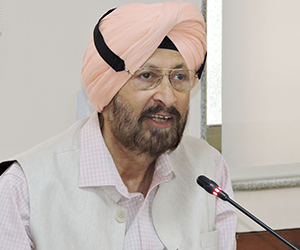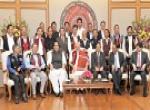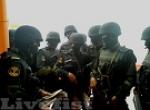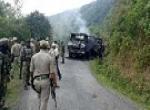Paresh Baruah’s United Liberation Front of Assam-Independent and S S Khaplang’s National Socialist Council of Nagaland (NSCN-K) have joined hands with seven other militant organisations active in India’s north-east to form the United National Liberation Front of West South-east Asia. According to news reports, the meeting took place in the Sagaing region of Myanmar where Chinese intelligence personnel are known to be active.
Several of India’s north-eastern states have been in a state of turmoil for many decades. The primary cause of strife is an unstable internal security environment that has been compounded by political and economic neglect. While the militant movements in the north-eastern states are mostly home grown, some of these have developed links with Pakistan’s ISI and international terrorist organisations like the LeT and HuJI.
Due to porous borders, the militants found it worthwhile to seek shelter in India’s neighbouring countries like Bangladesh and Bhutan. After the governments of the two countries joined hands with India to fight these extremists, they have been operating from bases in Myanmar with support from China.
Various Indian insurgent groups have found it convenient to operate out of bases in the weakly controlled areas in Myanmar, but the government of Myanmar does not encourage or support them. In April-May 1995, Operation Golden Bird was launched as a joint operation. Approximately 40 insurgents were killed and a huge cache of arms was recovered. Since then the two armies have been cooperating with each other for mutual benefit. In November 2001, the Myanmar army had raided several bases of Manipuri rebels and had rounded up almost 200 rebels and recovered 1,500 guns.
The intensity of instability varies from state to state. In Nagaland, peace had prevailed till recently due to the cease-fire that had held for 14 years. However, it was only a tenuous peace and various Naga and Manipuri factions remained engaged in a fierce internecine struggle for power in both these states. Political negotiations with the Naga leaders for a final settlement were proceeding extremely slowly. In early-April 2015, the NSCN (K) unilaterally abrogated the cease-fire.
In Tripura, violent incidents tend to break out at regular intervals and invariably lead to demands for the deployment of the Army and other security forces. In Mizoram, which has seen many years of relative calm, subterranean tensions have been simmering for some time and may again rise to the surface if these are not addressed satisfactorily.
In Assam, the situation has improved a great deal over the last five to six years. The ULFA leadership that was safely ensconced in Bangladesh could have been targeted only in conjunction with the government of Bangladesh. The government of Sheikh Hasina and the Bangladesh security forces extended the cooperation that was necessary for the launch of joint operations to apprehend the ULFA terrorists active against India.
The government of Bangladesh dismantled the infrastructure of the terrorists, including commercial organisations like hotels that ULFA was running quite openly, and stopped the flow of arms and ammunition across the border. In case such cooperation had not been forthcoming, India would have been forced to explore other options including covert operations to address the remaining roots of terrorism.
The counter-insurgency campaign against the remnants of the Paresh Baruah-led separatist ULFA cadres has made substantial headway and most of them have now taken shelter in Myanmar. The Bodo (NDFB) extremists have lost several senior cadres in recent encounters with the army and this extremist organisation too appears to have reached a discernible level of strategic fatigue. The NDFB may soon opt for negotiations with the government so as to buy time for resuscitation.
The traditional narrative in the north-east has been that illegal migration from Bangladesh into lower Assam has altered the demographic profile of the affected districts and added a sectarian dimension to the internal security challenge. Though the Muslim population of the state has grown from about 16 to 18 per cent in the 1950s and 1960s to above 30 per cent now, the insurgency in Assam has never been driven by religious fundamentalism.
The government claims that it has instituted various measures like border fencing, reduction of distance between one border outpost and another, increase in the strength of the riverine police and the provision of floodlights to detect and prevent infiltration. However, the measures had remained ineffective till the government of Bangladesh stepped in pro-actively to deny sanctuary to Indian militants.
The vibrant culture of the beautiful Brahmaputra basin, which gave birth to an ancient civilisation and was once a flourishing centre of trade has been torn asunder by militancy and terrorism that are now several decades old. Sporadic acts of violence, a gun culture, extortion and kidnappings now mark daily life, even though the security forces have succeeded in maintaining a semblance of normalcy.
Unless a political solution is found to solve the underlying socio-economic problems and to ameliorate the “hearts and minds” challenge of alienation from the national mainstream, full blown-militancy could again bounce back without warning in Assam.
The funds earmarked by the Central Government for development must trickle down to the people in a transparent and accountable manner. Central funds worth thousands of crores of rupees must not disappear without a trace as has happened in the past.
Over a period of more than half a century, the Indian army has successfully conducted a difficult counter-insurgency campaign in the north-eastern states, despite adverse terrain and weather conditions, logistics difficulties and political flip-flops. Military operations against the terrorists who are still active must continue unfettered.
However, the mistakes made in the early 1990s must not be repeated. When the situation had deteriorated, Operation Bajrang was launched but was soon called off as it became inconvenient for the newly elected government to have the army deployed in the state; six months later Operation Rhino was launched and was again inexplicably slowed downwhen limited success had been achieved.
The proclivity of successive state governments to scale down army operations for political reasons as soon as the situation improves visibly is always a major setback for the conduct of sustained counter-insurgency operations. The security forces need time to become effective and establish a counter-insurgency grid, including humint networks to gain actionable intelligence. ‘On-off’ deployment policies hamper operations and reduce the ability of the security forces to deliver effective results.
Policymakers and those who are responsible for governance must introspect and try to understand why the Indian state has repeatedly failed to successfully counter the long-festering militancy in Assam and other north-eastern states and address the root causes, which are mainly socio-political and socio-economic in nature.
The nation cannot sustain a high growth rate over a long period if a major region is not part of the success story and, in fact, acts as a drag on it. High opportunity costs are imposed on the national economy due to unrealised revenues and taxes and the cost of maintaining internal security. India’s quest to ‘act east’ and enhance its trade with ASEAN countries through the land route will also remain a non-starter unless durable peace returns to the north-eastern region.
Finally, the re-emergence of Chinese support for militant movements inimical to India’s interests after almost 30 years of non-interference is an ominous development. In case the Chinese succeed in getting the nine extremist organisation that they have helped bring together to coordinate operations and intelligence, it will pose a fresh challenge for India’s counter-insurgency campaign.
Published Date: 1st May 2015, Image Source: http://m.ucanindia.in










Post new comment